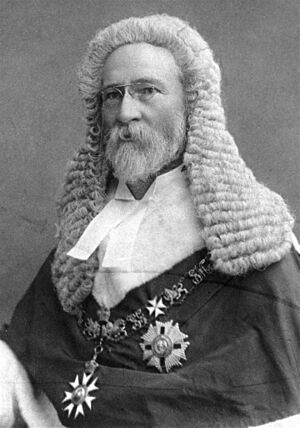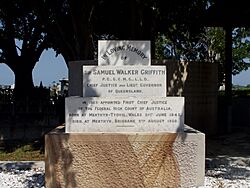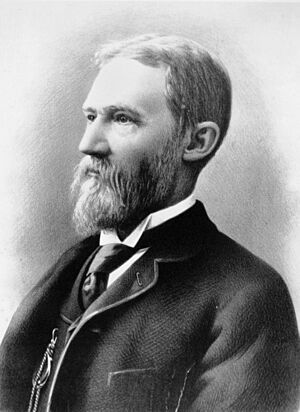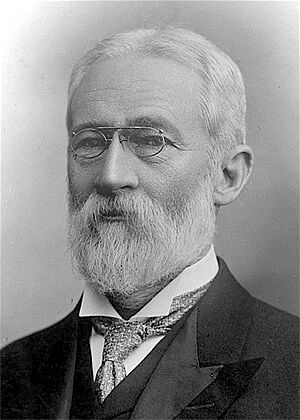Samuel Griffith facts for kids
Quick facts for kids
Sir Samuel Griffith
|
|
|---|---|
 |
|
| Chief Justice of Australia | |
| In office 5 October 1903 – 17 October 1919 |
|
| Nominated by | Alfred Deakin |
| Appointed by | Lord Northcote |
| Preceded by | office established |
| Succeeded by | Sir Adrian Knox |
| Chief Justice of Queensland | |
| In office 13 March 1893 – 4 October 1903 |
|
| Nominated by | Sir Thomas McIlwraith |
| Preceded by | Sir Charles Lilley |
| Succeeded by | Pope Cooper |
| 9th Premier of Queensland | |
| In office 12 August 1890 – 13 March 1893 |
|
| Governor | Sir Henry Norman |
| Preceded by | Boyd Dunlop Morehead |
| Succeeded by | Sir Thomas McIlwraith |
| In office 13 November 1883 – 13 June 1888 |
|
| Governor | Sir Anthony Musgrave |
| Preceded by | Sir Thomas McIlwraith |
| Succeeded by | Sir Thomas McIlwraith |
| Member of the Queensland Legislative Assembly | |
| In office 13 June 1888 – 29 April 1893 |
|
| Preceded by | New seat |
| Succeeded by | John James Kingsbury |
| Constituency | Brisbane North |
| In office 15 November 1878 – 13 June 1888 |
|
| Preceded by | New seat |
| Succeeded by | Abolished |
| Constituency | North Brisbane |
| In office 25 November 1873 – 14 November 1878 |
|
| Preceded by | New seat |
| Succeeded by | Samuel Grimes |
| Constituency | Oxley |
| In office 3 April 1872 – 25 November 1873 |
|
| Preceded by | Robert Travers Atkin |
| Succeeded by | William Fryar |
| Constituency | East Moreton |
| Personal details | |
| Born | 21 June 1845 Merthyr Tydfil, Glamorgan, Wales |
| Died | 9 August 1920 (aged 75) Brisbane, Queensland, Australia |
| Resting place | Toowong Cemetery |
| Political party | Independent |
| Spouse |
Julia Thomson
(m. 1870) |
| Relations | Mary Harriett Griffith (sister) |
| Alma mater | University of Sydney |
| Occupation | Politician, judge |
Sir Samuel Walker Griffith (June 21, 1845 – August 9, 1920) was an important Australian judge and politician. He was the very first Chief Justice of Australia, serving from 1903 to 1919. He also served as the Chief Justice of Queensland and was the Premier of Queensland twice. Samuel Griffith played a big part in writing the Australian Constitution.
Griffith was born in Wales. He moved to the Moreton Bay area of New South Wales (which is now part of Queensland) when he was eight years old. He studied at the University of Sydney and became a lawyer in 1867.
In 1872, Griffith was elected to the Queensland Legislative Assembly. He served as the Attorney-General and later became a leader of the liberal group in parliament. Griffith was Premier from 1883 to 1888 and again from 1890 to 1893. He helped create the Queensland Maritime Defence Force. He was also known for his support of workers' rights.
In 1893, Griffith left politics to become the head of the Supreme Court of Queensland. He helped write many laws, including Queensland's criminal code. Griffith strongly supported the idea of federation, which meant uniting the Australian colonies into one country. He helped write the first draft of the Australian Constitution.
When the High Court of Australia was created in 1903, Griffith was chosen to be its first Chief Justice. He heard many important cases about the Constitution. Griffith University and a suburb in Canberra are named after him.
Contents
Early Life and Education
Samuel Griffith was born in Merthyr Tydfil, Wales. He was the younger son of Edward Griffith, a minister. His family moved to the Moreton Bay area of New South Wales (now Queensland) when he was eight.
He went to schools in Ipswich and Sydney. He was known for being able to argue well on any topic. He later studied at the University of Sydney. He graduated in 1863 with high honors in classics, maths, and science.
In 1865, he traveled to Europe. He especially loved Italy and its literature. Years later, he became the first Australian to translate parts of Dante's famous work, The Inferno.
When he returned to Brisbane, Griffith studied law. He became a lawyer in 1867. In 1870, he finished his Master of Arts degree in Sydney. That same year, he married Julia Janet Thomson.
Political Career in Queensland
In 1872, Griffith was elected to the Legislative Assembly of Queensland. He always saw himself as a lawyer first and a politician second. He continued to work as a lawyer even when he held political office. In 1876, he became a Queen's Counsel, which is a special title for experienced lawyers.
Griffith was known as a reformer who wanted to make things better. He served as Attorney-General, Minister for Education, and Minister for Works. In 1879, he became the leader of the liberal group in parliament. His main political rival was Sir Thomas McIlwraith.
Griffith became Premier of Queensland in November 1883. He won the election partly by promising to stop the use of Kanaka labor from the islands. He passed a law for this, but it was not fully put into action because it might have harmed the sugar industry. However, he did make rules to stop the worst abuses in recruiting workers.
Griffith was Premier until 1888. He was honored with a knighthood in 1886. He was seen as a friend to the labor movement. He tried to pass a law to make trade unions legal. He said that the big challenge of his time was how to share wealth more fairly.
In 1888, his government lost power. While out of office, he wrote articles for a socialist newspaper called The Boomerang.
However, in 1890, Griffith surprised many by becoming Premier again. He formed an alliance with his former rival, McIlwraith. The next year, his government took strong action against leaders of the 1891 Australian shearers' strike. Griffith supported this decision. Because of this, some of his former supporters felt he had betrayed them.
Chief Justice of Queensland
On March 13, 1893, Griffith resigned from his political roles. He was then appointed as the Chief Justice of the Supreme Court of Queensland. He served in this role until October 4, 1903.
Because he was a judge, he could not be a delegate at the 1897-98 convention that created the Australian Constitution. However, he worked behind the scenes as an advisor. He helped Sir Robert Garran, who was the secretary of the committee that drafted the Constitution. The structure Griffith had created in 1891 was largely followed.
In 1899, he publicly supported a "yes" vote for the federation referendum in Queensland. In May 1900, he wrote the very last change to the Constitution. This change helped solve a disagreement about appeals to the Judicial Committee of the Privy Council.
During his time as Chief Justice, Griffith wrote Queensland's criminal code. This code successfully put all English criminal law into one clear document. It was adopted in 1899 and later used in other places like Western Australia and Papua New Guinea. Queensland's Criminal Code is still largely the same today.
Chief Justice of Australia
When the federal parliament passed the Judiciary Act 1903, it created the High Court of Australia. Samuel Griffith was the clear choice to be the first Chief Justice. He was appointed on October 5, 1903.
During his sixteen years on the High Court, Griffith heard about 950 cases. In 1913, he visited England and served on the Privy Council. Like Sir Edmund Barton, Griffith was often asked for advice by the Governors-General during times of political trouble.
Griffith was the first of two High Court judges who had also served in the Parliament of Queensland. After 1910, his health started to decline. In 1917, he had a stroke. In 1912, he published his translation of Dante's Divina Commedia.
Royal Commissions and Public Service
In January 1918, Prime Minister Billy Hughes asked Griffith to lead a Royal Commission. This commission looked into how many soldiers were needed for the Australian Imperial Force fighting overseas. This happened after a second vote on conscription had failed.
Griffith's report was finished in just one week. It was mainly a mathematical calculation about the number of soldiers needed. Prime Minister Hughes used this report to support his arguments during the conscription debate.
Some people later thought it was not a good idea for Griffith, as a High Court judge, to be involved in this Royal Commission. This is because the findings could be used for political reasons, which might seem to mix the roles of the court and politics. It was the last time a sitting High Court judge led a Royal Commission. However, in July 1918, he refused another request from Hughes for a judge to lead a commission. He said it would "associate the High Court with political action."
Retirement and Death

Griffith retired from the High Court in 1919. He passed away at his home in Brisbane on August 9, 1920. He is buried in Toowong Cemetery in Brisbane, along with his wife, Julia, and their son, Llewellyn. His grave is next to his good friend Charles Mein, whom he met at university.
Honors and Legacy
Many places and institutions are named after Sir Samuel Griffith to honor him. These include Griffith University, which has campuses across South East Queensland. The suburb of Griffith in Canberra is also named after him.
The federal electoral division of Griffith and Sir Samuel Griffith Drive on Mount Coot-tha in Brisbane also bear his name. The S.W. Griffith building at Brisbane Grammar School is named in his honor.
The Samuel Griffith Society is a group that works to protect the principles of the Australian Constitution, especially the idea of states' rights. A portrait of him hangs in the Brisbane Supreme Court.
In 2016, Griffith was added to the City of Maitland Hall of Fame. His former home, Merthyr, was named after his birthplace. The neighborhood of Merthyr in New Farm and Griffith Street are also named after him and his home.
See also
- List of Judges of the High Court of Australia
- List of Judges of the Supreme Court of Queensland



